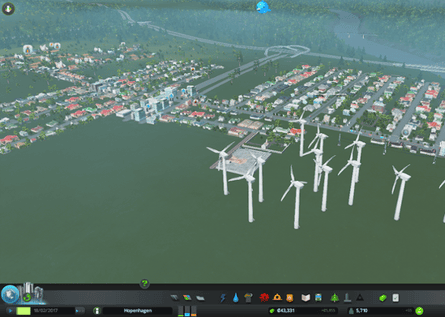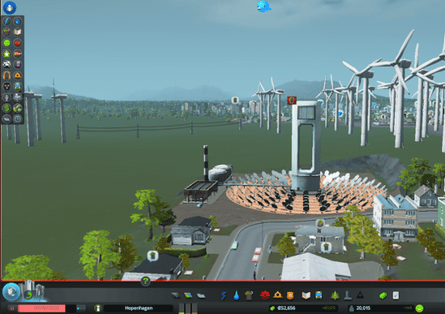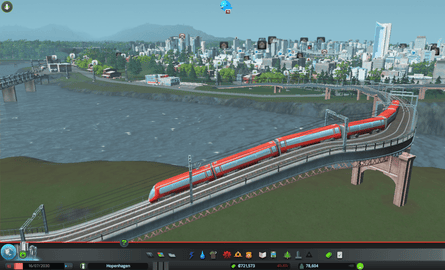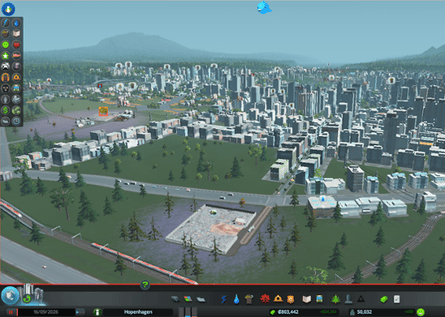Welcome to a city built with one goal: to be the greenest of bergs. I aimed to use the Cities: Skylines simulator to provide the residents of my little city (current population: 78k) with 100% renewable electricity, effective mass transportation and well-paid jobs in clean industries and high-tech sectors.
This is not a vision of some utopic future. The Danish capital Copenhagen, by some accounts the greenest city on Earth, uses today’s technologies and is en route to sustainability.
Could I go one better? Welcome to Hopenhagen.
Electricity

The first order was to provide power for my would-be denizens. The game allows you to start with wind or coal power. Coal is significantly cheaper than wind, but environmentally the choice is a no-brainer. Coal is the dirtiest of dirty fuels and there is no place for it in the cities of the future. By tapping its own enormous wind power resources, Copenhagen aims to become the first carbon neutral city in the world by 2025.
Eventually my city grew enough to build a solar power plant. The game is a little ahead of its time in making solar the cheapest form of electricity production - although this could happen within a decade. The fall in solar prices has been vertiginous. Power from large-scale solar is half the price it was five years ago and is approaching parity with coal and other fossil fuels.
Luckily my city had constant sunlight as well as wind. The game does not account for the dips in renewable supply that occur at night or on still or cloudy days. But also it does not give the option of exporting and importing power from a national grid to even out the peaks and troughs.

Transport
Transport is the thorn in every city council’s side - desperately expensive, dirty, noisy and terrible for the climate. And so it proves in this game. In an effort to provide my residents and industries with mass transport alternatives to roads, I spent hugely on metro systems, bus routes and rail connections. I planned neighbouring high-density residential and commercial spaces, so commuters had only short distances to travel between their office and apartments.
Yet still cars dominated, with Hopenhageners clinging to their gas guzzlers. Roll on the electric vehicle: in Denmark, one in 20 cars sold is battery-powered.
“Rip up all city streets with jackhammers… sod the streets at once.... All public movement would be by foot and a fleet of bicycles, maintained by the city police force.” Had the game allowed, I would have adopted Hunter S Thompson’s promise during his unsuccessful campaign for mayor of Aspen.
Bike transport is sorely overlooked in Cities: Skylines. Copenhagen’s Strøget, a central pedestrianised shopping area, has shown that with good mass transport and bike paths, major business districts can be magnificently car-free. By 2025, city officials say 75% of all journeys will be by foot, cycle or public transport.

Energy-efficient housing
The single most effective policy I adopted was a green housing initiative. It was costly, but was immediately repaid through a housing boom, as land value increased and owners invested in their homes.
This was pleasing because energy efficiency is often overlooked when it comes to greening cities. Despite its lack of sexiness, reducing energy demand through insulation, smart meters, double-glazing and efficient appliances “offers the best and most cost-effective chance to mitigate the worst effects of climate change”, according to the UK Green Building Council. In Copenhagen, a study found that heat demand from buildings could be reduced by up to 76%.
I also ensured that every street was lined with trees. Recent studies show that having 10 or more trees in your street makes you feel seven years younger.
Waste management
The biggest struggle for my city was rubbish. I resisted and resisted installing incinerators to burn the trash in my overflowing landfills. But eventually I had to relent, after thousands of people began deserting my trash- and (presumably) rat-infested city.
This is indeed a serious real-world stumbling block for all would-be eco-cities, including Copenhagen. Even though Danes create more household waste than any other EU country, they have one of the lowest landfill rates: much of the waste is burned instead, to create energy. Copenhagen dumps just 3% of its waste into the ground and incinerates 39%.
Recycling advocates say incinerators are an outmoded technology, one that locks us into the waste cycle and pumps out dangerous gases, including CO2, NOx, N2O and ammonia. Faced with a plan to build an incinerator, residents of the Italian town of Capannori decided to bypass the technology and employ a citizen-powered recycled programme. Landfill rates dropped from 60% to less than 20% in a decade. Unfortunately, Cities: Skylines does not give the option for such enlightened leadership.

The greenest?
Eventually, I think I probably came out on a par with Copenhagen. My electricity system was blessed by low cost and unrealistically favourable weather for renewable energy. But my transport system lagged far behind Denmark’s. For both the real Copenhagen and my simulated version, failure to develop a long-term solution to waste management remains a big hurdle.
I had one big advantage over my Danish peers, too. Unlike Copenhagen, my city begins on unpopulated plain, with plentiful resources and open spaces to plan and craft the most efficient city possible. The residents of Greensberg in Kansas were able to achieve something similar after a calamitous tornado destroyed 95% of their buildings in 2007. The town has since rebuilt as the greenest in the US. As for the rest of the world’s cities, most were vast and unmanageable before we even knew what ecological trouble we were making for ourselves.
Hopenhagen stats
Population: 78,577
Electricity from renewable sources: 100%
Resident happiness: 88%
Mass transit passengers: 4862/week
Water pollution: 0%
Ground pollution: 7%
Health: 79%
Cost of social policies (mostly green): $101,137.39 (40% of total expenditure)

Comments (…)
Sign in or create your Guardian account to join the discussion